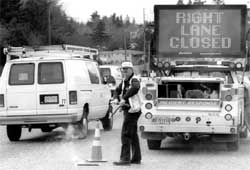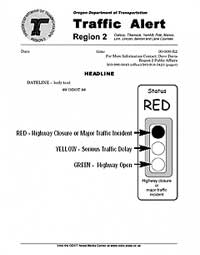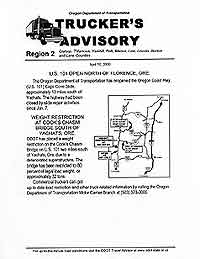Fact Sheet 1 - Oregon's QuickFax Service
July 2000
Truckers Get Immediate Information on on Traffic Delays and Closures
 Commercial
truckers can get up to-the-minute information on closures and traffic
delays on Oregon State highways through the Oregon Department of Transportation’s
(ODOT) QuickFax service. Bulletins are faxed to approximately 154 trucking
companies and 30 truck stops to inform them of immediate traffic delays
related to incidents or weather.
Commercial
truckers can get up to-the-minute information on closures and traffic
delays on Oregon State highways through the Oregon Department of Transportation’s
(ODOT) QuickFax service. Bulletins are faxed to approximately 154 trucking
companies and 30 truck stops to inform them of immediate traffic delays
related to incidents or weather.
This system was developed through ODOT’s public affairs department after a 1997 flood shut down many of Oregon’s major highways. “We were trying to keep the media informed about the road closures and it would take about three hours to fax the information out to all who needed it,” said Dave Davis, ODOT Region 2 Public Affairs. He said that by the time they got the information to all the media it was already outdated. Then U.S. West started a broadcast fax system, which delivers 50 faxes at once. This system cut notification time from 3 hours to 20 minutes.
Information Helps Truckers Plan Their Trips
 "It
seemed natural to develop this system for the trucking industry. We
contacted the Oregon Trucking Association and other organizations to
ask them to subscribe to the service,” said Davis. Initially the
service had about 50 trucking companies and a few truck stops as subscribers,
but the program has now become a staple of truckers in the Oregon area.
Trucking companies call in and get on the broadcast fax list. When incidents
and road closures occur, ODOT then sends an alert to QuickFax subscribers.
The service’s subscriber base reaches truck stops as far away
as Virginia, Nebraska, Wyoming, and California, so truckers heading
into Oregon from those locations can have advance warning of any long-term
road closures.
"It
seemed natural to develop this system for the trucking industry. We
contacted the Oregon Trucking Association and other organizations to
ask them to subscribe to the service,” said Davis. Initially the
service had about 50 trucking companies and a few truck stops as subscribers,
but the program has now become a staple of truckers in the Oregon area.
Trucking companies call in and get on the broadcast fax list. When incidents
and road closures occur, ODOT then sends an alert to QuickFax subscribers.
The service’s subscriber base reaches truck stops as far away
as Virginia, Nebraska, Wyoming, and California, so truckers heading
into Oregon from those locations can have advance warning of any long-term
road closures.
Stewart-Stiles Trucking Company in Salem, Oregon, is a QuickFax subscriber and dispatches the information to its truckers. Dispatcher Joe Darby said the information is useful because it alerts them in time to plan alternate routes for truckers. According to ODOT, this project defers 10 percent of traffic from a delayed area. Davis said, “Our goal is to prevent just one trucker from having to waste time sitting at a roadblock.” Additionally, he said the system has been extremely helpful in getting information to the media on traffic congestion on the heavily traveled I-5 corridor.
System Provides Flexibility for Getting the Message Out to a Specific Corridor of Traffic
This service also provides ODOT with various alternatives for using the system, said Laurie Gould, Region 4 Public Affairs. The broadcast fax system allows for a specific cluster of fax groups, which is useful for reporting information to a specific area. “If we have an accident on I-97, I can go to the fax machine and dial one number for the I-97 corridor group and send information to trucking companies, truck stops, and the media to let them know that the highway is closed.”
 QuickFax
Cost Is Worth It for Speed and Accuracy
QuickFax
Cost Is Worth It for Speed and Accuracy
ODOT’s Davis said the system is worth the $1,600 average monthly expense because of the speed in which you can get out information. Specific incidents have raised that cost to as much as $7,000 per month such as when a rock slide closed U.S. 101 for 3 months. Davis said they were sending out faxes every few hours when one lane was finally reopened. He said the lesson learned is to use the system only when traffic flow is affected for 3 hours or more.
Travelers, including truckers, can also get up-to-the-minute travel information at ODOT’s Travel Advisor at www.tripcheck.com.
Dave Davis
Oregon Department of Transportation
Region 2 Public Affairs Office
455 Airport Rd. SE, Bldg. B
Salem, OR 97301-5845
Phone: 503-986-5845
Fax: 503-986-5847
Victoria Kinne
Traffic & Safety Engineer
Federal Highway Administration
530 Center Street, N.E.
Salem, OR 97301
Phone: 503-399-5749
To share your Best Practices, contact:
Phillip Ditzler
Federal Highway Administration
400 Seventh Street, S.W.
Washington, DC 20590
Phone: 202-366-0855
U.S. Department of Transportation
Federal Highway Administration
Publication No. FHWA-OP-00-022
